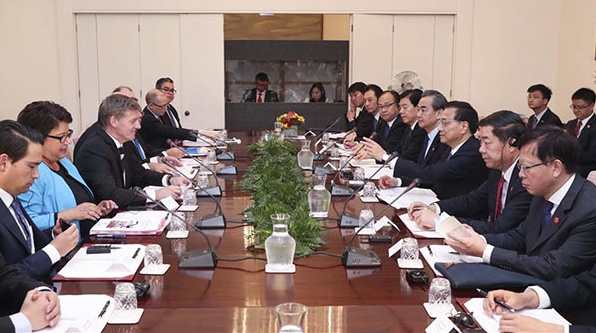B&R agreement a model for win-win cooperation

Chinese Premier Li Keqiang (3rd R) and his New Zealand's counterpart Bill English (3rd L) hold talks in Wellington, New Zealand, March 27, 2017. [Photo/Xinhua]
A cooperation agreement on the Belt and Road (B&R) Initiative was signed between China and New Zealand during Chinese Premier Li Keqiang's visit to the Oceanian country.
New Zealand became the first Western developed country to join the initiative, which was proposed by China in 2013 with the aim of building a trade and infrastructure network connecting Asia with Europe and Africa along ancient trade routes.
It is not by chance that China and New Zealand have set many records in their bilateral relations since they established diplomatic ties in 1972. New Zealand was the first Western developed country to conclude bilateral negotiations on China’s WTO entry, the first to acknowledge China's full market economy status, the first to sign and implement a bilateral Free Trade Agreement (FTA) with China, the first to join the China-initiated Asian Infrastructure Investment Bank (AIIB) as a founding member and the first to hold a nationwide Chinese Language Week. It is clear that New Zealand has taken the lead in forging strong ties with China.
Both sides give top priority to open cooperation, which became an important foundation for reaching the cooperation agreement on the initiative. Against the backdrop of a sluggish global economy, rising protectionism and anti-globalization sentiment, they are engaged in FTA upgrading negotiations.
This shows they are making substantial moves in support of liberalization of trade and investment and consolidating the confidence in economic globalization.
New Zealand recognizes China's economic development achievements and sincerity and capability in offering the world public goods as is shown by its Belt and Road Initiative. Some countries have expressed doubts over the past three years and there is also misunderstanding in the international community. However, China adheres to the principles of joint consultation, co-construction and sharing in promoting the initiative, and its efforts have been recognized and supported by an increasing number of countries, producing remarkable outcomes.
China has signed FTAs with 11 countries and bilateral investment agreements with 56 countries along the B&R routes. By June 2016, it had invested a total of US$51.1 billion in relevant countries, with 52 economic and trade cooperation zones established in 18 of them.
It will host the Belt and Road Forum for International Cooperation in May when the initiative will embrace a new milestone in its development.
As this year marks the 45th anniversary of China-New Zealand diplomatic relations, signing of the cooperation agreement underlines the strong bilateral ties and an expectation of opening up new prospects for cooperation.
(Su Xiaohui is deputy director of the Department for International and Strategic Studies with China Institute of International Studies. The article was translated by Zhang Junmian from an unabridged version published in Chinese.)
- China Int'l Supply Chain Expo New Zealand roadshow focuses on agricultural dairy industry, renewable energy
- GLOBALink | China is playing increasingly important role in mathematics: Artur Avila
- Chinese FM to visit New Zealand, Australia
- New Zealand's Silver Fern Farms looks to expand China footprint
- China's e-commerce logistics index up in 2023

